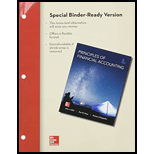
1.
Compute inventory turnover for each company for the most recent years shown.
1.
Explanation of Solution
Inventory turnover:
This is the ratio which analyzes the number of times inventory is sold during the period. This ratio gauges the efficacy of inventory management. Larger the ratio, more efficient the inventory management.
Calculate inventory ratio for Company A’s current year as follows:
Calculate inventory ratio for Company A’s one year prior as follows:
Calculate inventory turnover ratio for Company G’s current year as follows:
Calculate inventory turnover ratio for Company G’s one year prior as follows:
2.
Compute days’ sales inventory for each company for three years shown.
2.
Explanation of Solution
Days’ sales Inventory:
Days’ sales in inventory are used to determine number of days a particular company takes to make sales of the inventory available with them.
Calculate days’ sales inventory for the Company A’s current year as follows:
Calculate days’ sales inventory for the company A’s one year prior as follows:
Calculate days’ sales inventory for the Company A’s two year prior as follows:
Calculate days’ sales inventory for the Company G’s current year as follows:
Calculate days’ sales inventory for the Company G’s one year prior as follows:
Calculate days’ sales inventory for the Company G’s two year prior as follows:
3.
Comment and interpret your findings from parts 1 and 2. Assume an industry average for inventory turnover of 15.
3.
Explanation of Solution
Interpret and Comment:
- Company A’s inventory turnover ratio is more efficient than Company G.
- Company A’s days’ sales inventory is fewer than company G.
- Company A’s inventory turnover ratio is more than the industry average of 15 for inventory turnover for both the current year and prior year, but Company G is slightly below the industry average in both the current year and prior years.
- Company G’s days’ sales inventory seems a bit too high comparing with the Company A.
Want to see more full solutions like this?
Chapter 6 Solutions
Principles of Financial Accounting, Chapters 1-17 - With Access (Looseleaf)

 AccountingAccountingISBN:9781337272094Author:WARREN, Carl S., Reeve, James M., Duchac, Jonathan E.Publisher:Cengage Learning,
AccountingAccountingISBN:9781337272094Author:WARREN, Carl S., Reeve, James M., Duchac, Jonathan E.Publisher:Cengage Learning, Accounting Information SystemsAccountingISBN:9781337619202Author:Hall, James A.Publisher:Cengage Learning,
Accounting Information SystemsAccountingISBN:9781337619202Author:Hall, James A.Publisher:Cengage Learning, Horngren's Cost Accounting: A Managerial Emphasis...AccountingISBN:9780134475585Author:Srikant M. Datar, Madhav V. RajanPublisher:PEARSON
Horngren's Cost Accounting: A Managerial Emphasis...AccountingISBN:9780134475585Author:Srikant M. Datar, Madhav V. RajanPublisher:PEARSON Intermediate AccountingAccountingISBN:9781259722660Author:J. David Spiceland, Mark W. Nelson, Wayne M ThomasPublisher:McGraw-Hill Education
Intermediate AccountingAccountingISBN:9781259722660Author:J. David Spiceland, Mark W. Nelson, Wayne M ThomasPublisher:McGraw-Hill Education Financial and Managerial AccountingAccountingISBN:9781259726705Author:John J Wild, Ken W. Shaw, Barbara Chiappetta Fundamental Accounting PrinciplesPublisher:McGraw-Hill Education
Financial and Managerial AccountingAccountingISBN:9781259726705Author:John J Wild, Ken W. Shaw, Barbara Chiappetta Fundamental Accounting PrinciplesPublisher:McGraw-Hill Education





